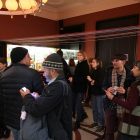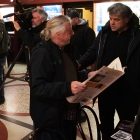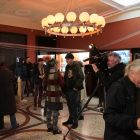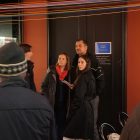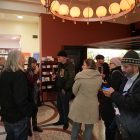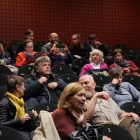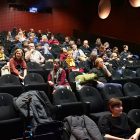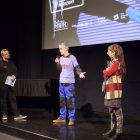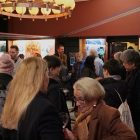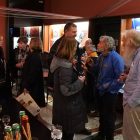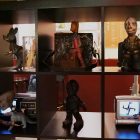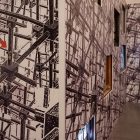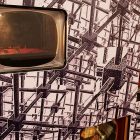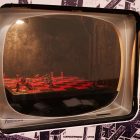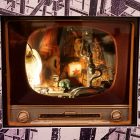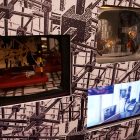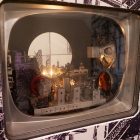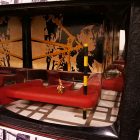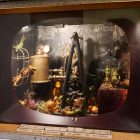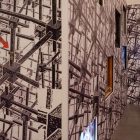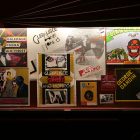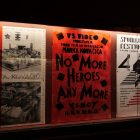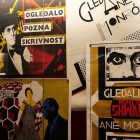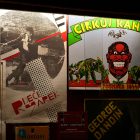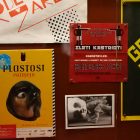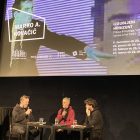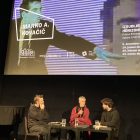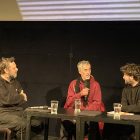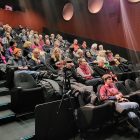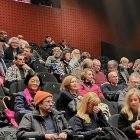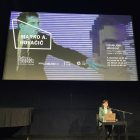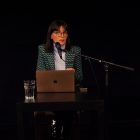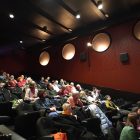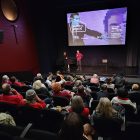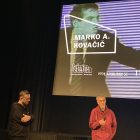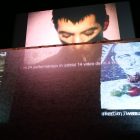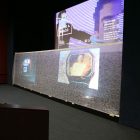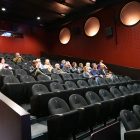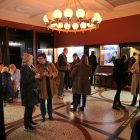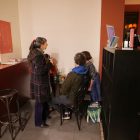Screening of Marko A. Kovačič’s film/video opus from 1983–2021
Screenings, exhibition and talks
Opening: Tuesday, 6 December 2022, 8 pm (screening and exhibition)
Slovenian Cinematheque, Miklošičeva cesta 28, Ljubljana
Programme at the Slovenian Cinematheque (December 2022 – March 2023)
6 December 2022 / 24 January / 28 February / 23 March 2023
The programme prepared by: SCCA-Ljubljana and Slovenian Cinematheque
Curators: Barbara Borčić, Peter Cerovšek
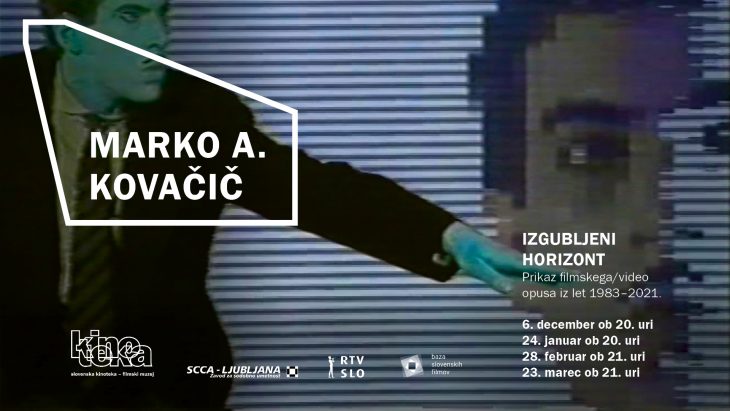
The programme of Marko A. Kovačič‘s artistic opus with screenings, an exhibition and accompanying programme is being prepared in cooperation with the Slovenian Cinematheque. We keep his works in the archive of DIVA Station and have been systematically researching them recently, as the artist is one of the important representatives of film and video creativity in Slovenia. From now on, Kovačič’s film and video opus will also be stored in the archives of the Slovenian Cinematheque.
For the first time, Marko A. Kovačič’s works will be comprehensively put on display and for consideration by experts and the general public, as well as the younger generation, who may not yet be familiar with them. Short films and video works are rarely shown here in cinemas or on television, more or less they can only be seen at festivals (e.g. FeKK short film festival and V-F-X Ljubljana festival of experimental audiovisual practices). The program, which will also be partially accessible on the Slovenian Film Database (BSF) online, will take us through Kovačić’s forty-year opus with screenings once a month from December 2022 to March 2023, which includes narrative, performative, experimental and documentary works, from the early analog on magnetic tape (VHS, U-matic, Beta) to later digital formats. In addition to the author, experts of film, video, new media and the author’s works will participate in the programme: Barbara Borčić, Peter Cerovšek and Igor Prassel.
The poster exhibition and the video installation The Surviving City in the Cinematheque Cafe (6–31 December 2022) will at least somewhat demonstrate the multimedia dimension of Kovačič’s artistic practice.
All this is a good reason for happy celebration, because after the three joint projects so far (Miha Vipotnik, Ema Kugler, Marko A. Kovačič) there is promise of a continuation of this kind of cooperation in the fields of screening, critical reflection and preservation of audiovisual cultural heritage.
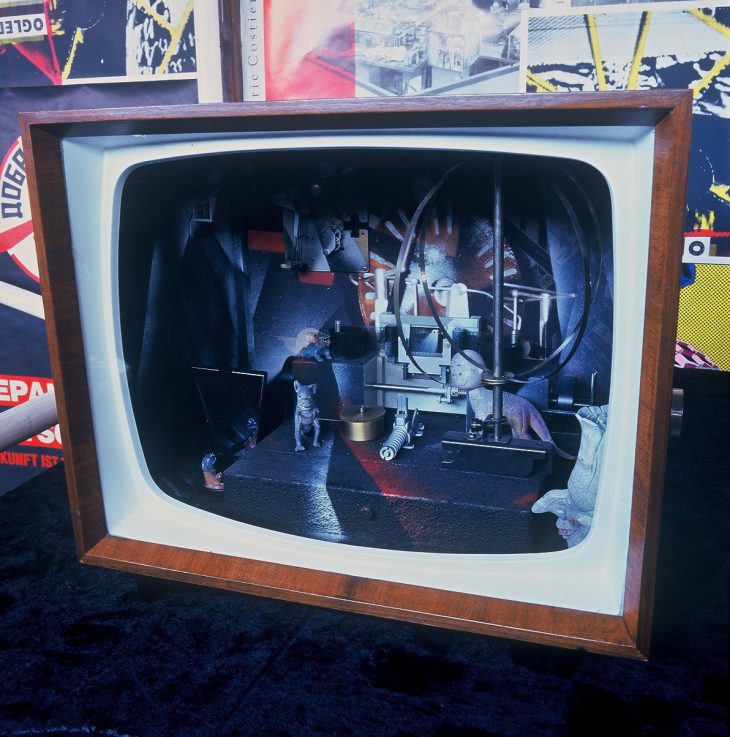
The Surviving City installation will open a view of the different perspectives and media of Marko A. Kovačič’s creation, which is closely related to the world of Plastos and the artist’s perception of perspective, depth of field and the sparkling search for solutions in a DIY manner. For these creatures from the future, the artist created fantastic futuristic environments and videos dominated by the character of props and scenes: mechanical figures, chambers, peepholes, TV objects, a hrupofon (bruitphone) and a model of the city of Katastropolis.
PROGRAMME I
Tuesday, 6 December 2022, 8 pm
The first programme of Marko A. Kovačič’s opus focuses on the subject of the Plastos Civilization, which employs the author in a series of installations, performances and video works, while using narrative, experimental and performative approaches. The central place belongs to the author’s video Forth Into the Past – a comprehensive presentation of the constructed world of Plastos, creatures from organic and mechanical parts that will mutate, survive and found the city of Katastropolis after wars, ecological and other disasters.
The screening will be followed by the opening of the video installation The Surviving City and the poster exhibition, which will be on display in the cinema cafe between 6 and 31 December 2022.
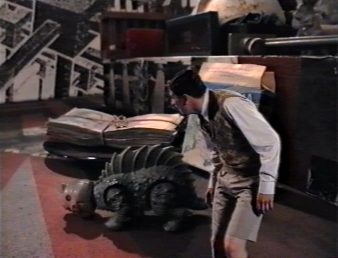
Marko A. Kovačič, Slovenia, 1995, digital format (shot on Beta SP), colour, 10′
» video
The video deals with our understanding of the distant future, presented through a concrete example of the 23rd-century archaeology. A narration of a professor archaeologist leads us through the story as he guides his student through one of the main archaeological sites in the City of Catastropolis. The so-called Plastoses, half-organic half-mechanical creatures who (will) survived the atomic catastrophe in 2223, live there. The main expressive means of the video is chroma key with well-crafted imaginary backgrounds, designed to the minutest detail in author’s studio. The author combines artistically imagined scenography with performance elements and completes it with digital animation.
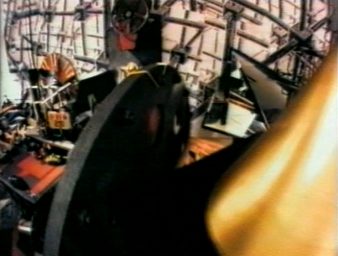
Marko A. Kovačič, Slovenia, 1997, digital format (shot on mini DV), colour, 1′
» video
A one-minute flyover of the city of Katastropolis, built by the artist as a maquete – the basic setting for the video Forth into the Past. It is composed of artworks, artefacts and found objects from different materials, techniques, spaces and times.
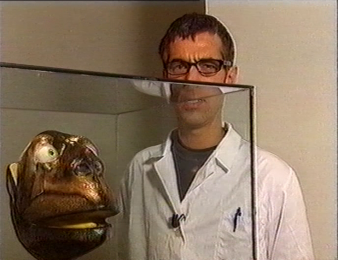
Igor Vrtačnik, Slovenia, 2001, digital format, colour, 21′
The documentary about the Civilization of Plastos was created within the scientific editorial board of TV Slovenia. It accompanies the scientist and guardian of Plastoses, Dr. Skavchenko in his secret laboratory and on the path of new discoveries during loving encounters with these friendly creatures and also reveals some details from their daily lives.
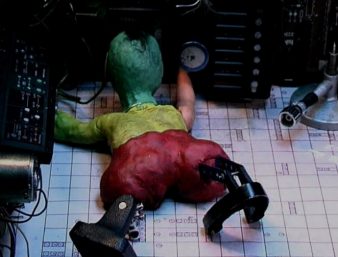
Marko A. Kovačič, Kolja Saksida, Slovenia, 2002, digital format (shot on mini DV), colour, 4’40”
» video
The animations are the result of authorial collaboration between animator Koljo Saksida and artist Marko A. Kovačič, author of the fictional post-apocalyptic Civilization of Plastos. They are characterized by a combination of computer graphics and stop-motion animation. Lab Party is a story about the cloning and genetic mechanical mutation of living beings after the year 2227. The setting is a laboratory where laboratory technician Plastos encounters problems.
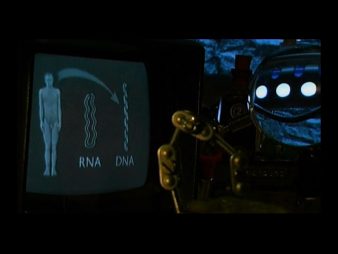
Marko Kovačič, Kolja Saksida, Slovenia, 2003, digital format (shot on mini DV), colour, 6′
» video
The animations are the result of authorial collaboration between animator Koljo Saksida and artist Marko A. Kovačič, author of the fictional post-apocalyptic Civilization of Plastos. They are characterized by a combination of computer graphics and stop-motion animation. Bright Future shows a base laboratory near Saratov, where a doctor is making a fast Plastos Fedor to cope with the radioactive Kyrgyz steppe.
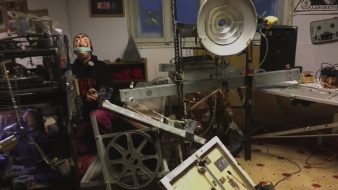
Marko A. Kovačič, Slovenia, 2020, digital format, colour, 3’21”
» video
During the corona pandemic and forced isolation, Yevgenij Skavchenko, an expert in genetic mechanics and a fan of unusual sound phenomena, visits the Plastos’ temporary residence in “Javka pri Rdeči zvezdi” (The Post at the Red Star). With the help of the hrupofon (bruitphone, noisemaker), a light-sound instrument, they perform the ritual of the cult of speed together.
PROGRAMME II
Tuesday, 24 January 2023, 8 pm
An overview of the author’s video works, from the legendary multimedia project Casus Belli to the first births of performative detective characters immersed in models, installations and images of the Disney-noir macro video world. In this world, the author also places the politically engaged grotesque No More Heroes Any More, and in the end he allows us to return to the everyday social realism of workers’ utopias and dystopias.
After the screening, Peter Cerovšek and Igor Prassel will talk to the artist.
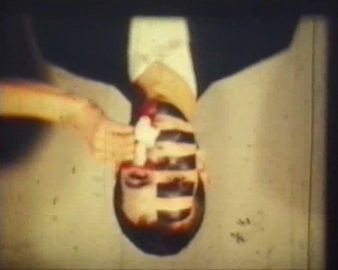
Marko A. Kovačič, Slovenia (Yugoslavia), 1983, digital format (shot on VHS), colour, 17′
» video
The video was created on the basis of a performance of the same name in the Škuc Gallery in Ljubljana in 1983, which took place at the intersection of constructed and real space, movement and static, figure silhouettes and a real vulnerable body.
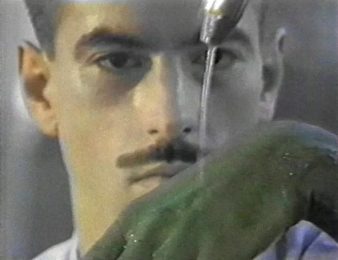
Marko A. Kovačič, Slovenia (Yugoslavia), 1985, digital format (shot on VHS and U-matic), colour, 16′
» video
The story of the narrative is based on the genre of crime fiction. The images are filled with citations from the history of art and cinema and refer to, for example, Man Ray and Sergei Eisenstein. The dynamics of the image is matched with the music is characterized by cinematic suspense.
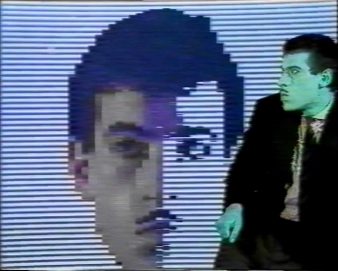
Marko A. Kovačič, Slovenia (Yugoslavia), 1987, digital format (shot on U-matic), bw, 2’30”
» video
The video was on the basis of a performance of the same name at the Glej Theater in Ljubljana. Using a digital mirroring effect and a time delay, the author splits the protagonist (himself) into the pursuer and the pursued.
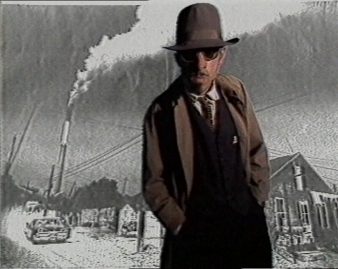
Marko A. Kovačič, Slovenia (Yugoslavia), 1986, digital format (shot on U-matic), colour, 6’45”
» video
An ambivalent deconstruction of the fantasy of the promised land and faith in art, which takes place in a stereotypical game of constant hide-and-seek. It is a dialectical confrontation of the kind of heroism of the regime, which operated with prohibitions and detachment from the people, with the announcement of a rapprochement with Western systems of liberal capitalism.
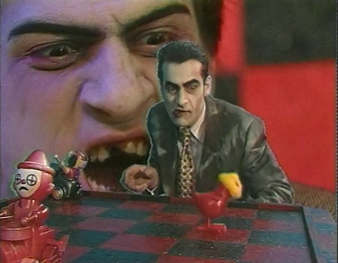
Marko A. Kovačič, Slovenia, 1992, digital format (shot on Beta SP), colour, 18’15”
» video
In a parodic and grotesque way, the video tackles the subject of war through a game of chess and refers to the war in Bosnia and the conduct of international politics with numerous references. It is a commentary on war, on the theater of military mechanics, and suggests that war is a game of strategy, that weapons are the toys of adults.
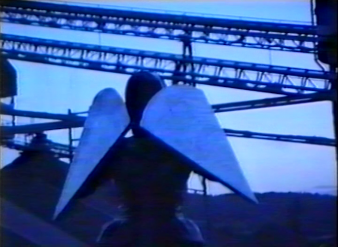
Marko A. Kovačič, Slovenia, 1993, digital format (shot on Video8), colour, 4′
» video
The video was created on the basis of a group performance in the urban environment Bellum contra solem of the Fusnet Association, which was staged in a block settlement in Nova Gorica on the summer solstice in 1991. The arrival of the Four Horsemen of the Apocalypse in fantastic futuristic costumes – the Conquest, War, Hunger and Death – in a Ljubljana sand pit illustrates the time around the declaration of Slovenian independence and the break away from the Yugoslav state.
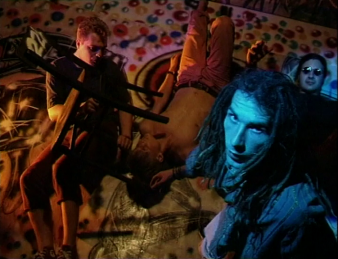
Marko A. Kovačič (music video of 2227), Slovenia, 1993, digital format (shot on Beta SP; Digital D3 mastering), colour, 6’20”
» video
The music video for the song I’ve seen that … Like it is by the Ljubljana music group 2227 combines footage of the concert and graffiti projections of the Strip Core collective.
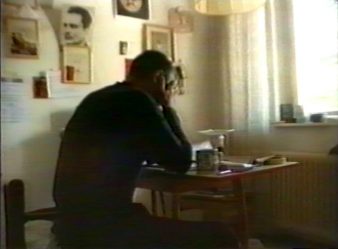
Marko A. Kovačič, Slovenia, 2000, digital format (shot on mini DV), colour, 1’20”
» video
A short one-minute video showing excerpts from newspaper articles about May Day celebrations and the author’s morning reflection on the changed meaning of this holiday.
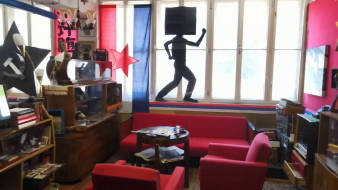
Marko A. Kovačič, Slovenia, 2021, digital format, colour, 2’40”
» video
During the corona pandemic in 2020 and 2021, the author opened Javka pri Rdeči zvezdi (Post at the Red Star) in the former Mehanika factory and now Ropotarnca in Trbovlje to the public. In the heart of the once proletarian and revolutionary Red Districts, he performed the most complex staging of his fascinating forty-year artistic process to date, and through art encompassed social periods full of contradictions and paradoxes.
PROGRAMME III
Tuesday, 28 February 2023, 9 pm
A program of film works by Marko A. Kovačič, which derive from the author’s new-wave and expressive performances, the dramaturgical performative dynamics of the Ana Monro Theatre or the humorous epic of the music-visual group Zlati Kastrioti. Thematically, they encompass the author’s recognizable motifs and visual image, everything from shifting identities, erotica, politics and psychoanalysis to the satirical genre exploration of the detective story with an intertwining of the personal and the artistic.
The screening will be introduced by media theorist dr. Melita Zajc.
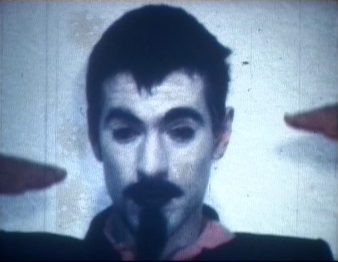
Marko A. Kovačič, Slovenia (Yugoslavia), 1983, Super8, colour, 13’30”
» video
The author’s first work is an experimental miniature that addresses the basic building blocks of film and dissects and explores the moving image and medium of film. The body is a painter’s canvas, geometric figures are mise-en-scene, performance is a study of movement, masking and disguise.
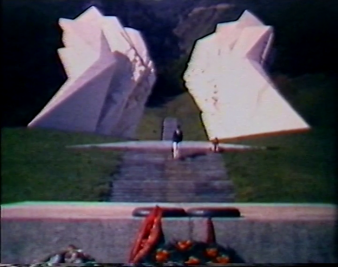
Marko A. Kovačič, Slovenia (Yugoslavia), 1984, Super8, colour, 4’37”
» video
A genre counterpoint of personal and public, of provocation and seduction, which is read precisely between these cracks.
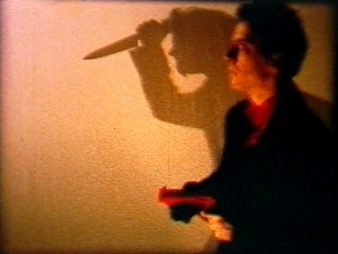
Marko A. Kovačič, Slovenia (Yugoslavia), 1985, Super8, colour, 20′
» video
In the manner of crime movies, hide and seek, the film moves between the genres of detective and horror and around the mysterious microfilm. It is also characterized by a touch of burlesque. It represents the atmosphere and image of its time on the Ljubljana alternative scene of the 1980s. Part II was shown as a prequel to the Ana Monro Theatre’s performance of The Red Beam.
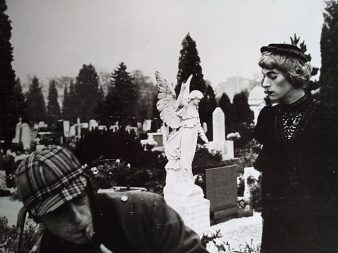
Marko A. Kovačič and Ana Monro Theatre, Slovenia (Yugoslavia), 1984, 16 mm, b&w, 5′
» video
The film with two main characters (Inspector Shwake and Doctor Marek) tells about the gracelessness of war, the manufactured causes and the attempt to change the course of events and prevent the war. The film was originally screened as part of the Ana Monro Theater play of the same name.
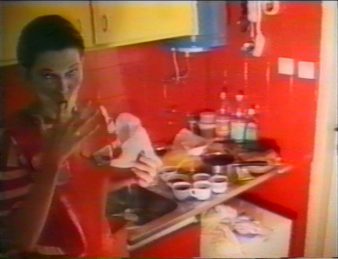
Marko A. Kovačič and Ana Monro Theatre, Slovenia, 1993, digital format (shot on U-matic in Beta SP), 12’20”
» video
The happening takes place in the real environment of Mrs. Salendrova’s half-destroyed apartment and presents a kind of visual record of the performance of the Ana Monro Theatre. The film is made up of various gags of Monro’s eccentric protagonists, who differ from the boring but at the same time cruel collapsed walls and urban environment with their bizarre appearance and gestures.
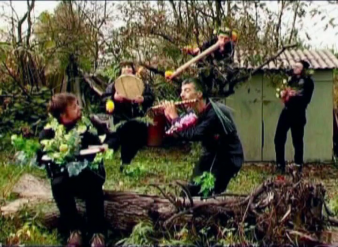
Marko A. Kovačič and VIS Zlati Kastrioti, Slovenia, 2004, digital format (shot on mini DV), 29′
» video
A film in the genre “the silent musical” was originally screened with live music (VIS Zlati Kastrioti). It creates a Kastrioti story about a mother who leaves her children to their fathers due to a stormy spirit, unspoken love and the realization of the truth.
PROGRAMME IV
Thursday, 23 March 2023, 9 pm
The programme presents a 3-channel video installation on the stage of the Slovenian Cinematheque, based on Kovačič’s retrospective work Dossier 83:03. In it, the author presents to the viewer a voluminous artistic file of his twenty-year creation. The events-images line up in front of the viewer as sequences and are assembled through time and space into a narrative based on personal and collective history. Documentary, media and work recordings are interwoven with personal memories, contextual comments and the author’s reflections. Twenty years later, reflection in the video space is also offered to visitors of the Slovenian Cinematheque.
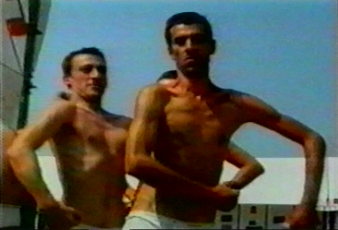

POSTER EXHIBITION
6 – 31 December 2022
Cinematheque Cafe
Marko A. Kovačič brought the multimedia dimension of his artistic practice into the posters he designed for his videos, performances, exhibitions and group projects. He started working with spatial and graphic design in 1981, when he and Andrej Rozman – Roza founded the Ana Monro Theatre, for which he spent years developing an integrated visual, graphic and scenic image with props, photo montages and film material. He built posters similarly to his spatial installations and also established a space-figure relationship on a two-dimensional support. They were based on constructivist principles and processes of collage and photomontage, often in a black and red color scale. Photography — its appropriation and inclusion in the form of a screen (scenes from films or photos of actors) — together with well-thought-out typography, became a distinguishing sign of his graphic structure in various techniques (xerox, black-and-white or color printing, unique street posters).
Posters at the exhibition: 4th Spring Festival (1983), The Mirror Knows the Secret (1986), No More Heroes Any More, Mladinsko Theatre (1992), Katastropolis 2227, Loža Gallery, Koper (1995); Ana Monroe Theatre (1984, 1990): Red Ray, Inspector Swake, George Dandin, Cirkus Kansky, Sanremo.
THE AUDIOVISUAL PRACTICE OF MARKO A. KOVAČIČ
Although a sculptor by training, Marko A. Kovačič focused on moving images and performative practices early on. Already his first work, Casus Belli, consisted of an art film, a performance and an art video. The creative procedures, complex instrumentation, use of media and thematic framework present there become recognizable building blocks of his practice and form a recognizable author’s style. It is characterized by the principles of constructivism and popart, the author’s performativity and close involvement in all creative phases of the creation of an AV work, as well as processuality in the construction of narratives that have social and political dimensions. He doesn’t teach, rather he gives us funny hints, which are no less serious because of that.
As a member of the Ana Monro Theatre, he transferred the choreography of street theater movements to his AV works, in which the body and ritual play an important role. He created characteristic characters, which he mostly played himself and inserted into a pre-made scenography – often in the macro world of assemblages, collages and bricolage. He enlarged this world into video environments using the inlay technique – inserting one image into another using the chroma key process and creating specific effects. He enforced the play of perspective and the position of the gaze both with video and film effects as well as with spatial installations and created a layered view that reached beyond the typical horizon and which is associated with performative magic tricks.
All this led him to discover a new system, a different reality and a special equation of evolution, which he calls The Plastos Civilization. He introduced time as a dynamic process in an endless cycle and a constructed space/world that is a game of changing images and ideas. Even if his works seem fictitious, scientific discoveries and social changes are the subjects of Kovačić’s artistic reflection and criticism. This branches through his works with the breath of a humorous undertone or as grotesque and indirectly conveys that retreating into the fictional realm is the only way to face reality, political, existential or personal.
Installations and performances (selection)
Casus Belli, Galerija ŠKUC + 1. mednarodni video bienale VIDEO CD (1983) | Strike + 1492, ljubljanske ulice (1984) | Ogledalo pozna skrivnost, Gledališče GLEJ + Gledališče Zeleste, Barcelona (1986) | Jupitrova daritev, Dioklecijanova palača, Split (1987) | Programiranje pogleda, Galerija ŠKUC (1988) | Rekviem, Moderna galerija (1989) | Bellum contra solem (Asociacija Fusnet), Nova Gorica (1991) | Boxman, Klub K4 (1991) | Heroji padajo, Slovensko mladinsko gledališče (1992) | Naprej v preteklost, Galerija ŠKUC (1994) | Laterna magica, Mala galerija (1995) | Katastropolis 2227, Galerija Loža, Koper (1995) | Disinfected for Your Protection, CCA, Varšava (1996) | Izgubljeni horizont, Galerija Kapelica (1997) | Preživelo mesto, Galerija Kapelica + Limerick (1999) | Plastos: Paleontropološki muzej, Razstavni salon Rotovž, Maribor (2001) | Civilizacija Plastosov, Narodni muzej (2002) | Plastoratorij, Galerija Kapelica (2004) | Ljubeči pogled, Mestna galerija (2006) | Rdeča figura, festival Šteglinec (2008) | Sub-avkcija, Galerija Alkatraz (2009) | Prometejeve iskre, Kino Šiška (2010) | Hrupofonija, MGLC (2010) | Hrupofon, Galerija Simulaker, Novo mesto (2012) | Ernesto Che Guevara Camp, Lovčen + festival Riga in Talin (2013) | Kontejner, Svetlobna gverila, Trg francoske revolucije (2015) | Disput v ateljeju (+ Andrej Pezelj), AKC Metelkova mesto (2015) | Jesensko hrupanje, Peklensko dvorišče (2017) | enTRANCE, Festival Sajeta, Tolmin (2020) | Peti element, Pixxelpoint, Nova Gorica (2020) | Javka pri rdeči zvezdi, Trbovlje (2021).
*Unless stated otherwise, the city is Ljubljana
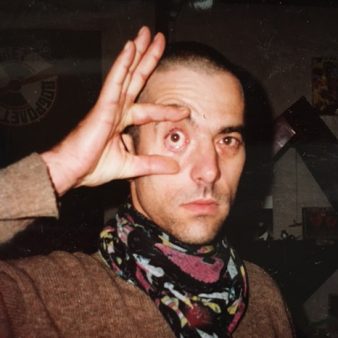 Marko A. Kovačič (1956) is a multi-media and interdisciplinary artist who has made an important mark on the Slovenian cultural space with his works. His forty-year opus includes art films and video works, performances, installations and environments. The specifics of his practice are the integration of media, imaginary narration, changing roles and personal identities. In the 1980s, as a protagonist of the Ljubljana alternative scene, he staged the anthology new wave performance Casus Belli. With characteristic irony, he tackled political themes and social changes, injecting a great deal of humor and absurdity into his works. His video No More Heroes Any More, a parable about politics and war, staged as a game of chess, was included in its collection by media archive Transitland (Berlin). Parallel to his experimentation, ever since his fascination with “montage ecstasy”, he developed a personally engaged reflection of contemporary social phenomena and, in the spirit of historical avant-gardes, also thematized the concepts of museum institutions and collections, television, political ideologies and social utopias. When he staged his own television in empty TV boxes, which he filled with his mise-en-scènes, he was declared “our richest television company”. With Subauction (lowering the price by destroying the artwork), he thematized the position of the independent artist. All the time he pondered the relationship between art and science, past and future, personal and collective memory. In the 1990s, he designed the sci-fi Civilization of Plastos, beings from the future, and created fantastic futuristic environments and videos dominated by the character of props and scenes (mechanical figures, peepholes, TV objects, a model of the city of Katastropolis, a hrupofon (bruitphone). With the full measure of collecting passion, he first set up his museum collection in the Škuc Gallery in 1994 and, during the pandemic in 2020, developed it into a “museum of our and your half-past history” in The Post at the Red Star in Trbovlje.
Marko A. Kovačič (1956) is a multi-media and interdisciplinary artist who has made an important mark on the Slovenian cultural space with his works. His forty-year opus includes art films and video works, performances, installations and environments. The specifics of his practice are the integration of media, imaginary narration, changing roles and personal identities. In the 1980s, as a protagonist of the Ljubljana alternative scene, he staged the anthology new wave performance Casus Belli. With characteristic irony, he tackled political themes and social changes, injecting a great deal of humor and absurdity into his works. His video No More Heroes Any More, a parable about politics and war, staged as a game of chess, was included in its collection by media archive Transitland (Berlin). Parallel to his experimentation, ever since his fascination with “montage ecstasy”, he developed a personally engaged reflection of contemporary social phenomena and, in the spirit of historical avant-gardes, also thematized the concepts of museum institutions and collections, television, political ideologies and social utopias. When he staged his own television in empty TV boxes, which he filled with his mise-en-scènes, he was declared “our richest television company”. With Subauction (lowering the price by destroying the artwork), he thematized the position of the independent artist. All the time he pondered the relationship between art and science, past and future, personal and collective memory. In the 1990s, he designed the sci-fi Civilization of Plastos, beings from the future, and created fantastic futuristic environments and videos dominated by the character of props and scenes (mechanical figures, peepholes, TV objects, a model of the city of Katastropolis, a hrupofon (bruitphone). With the full measure of collecting passion, he first set up his museum collection in the Škuc Gallery in 1994 and, during the pandemic in 2020, developed it into a “museum of our and your half-past history” in The Post at the Red Star in Trbovlje.
He graduated from the ALUO in Ljubljana and completed postgraduate studies in sculpture there (1988). He was a member of the Ana Monro Theatre (1981–1993), the artistic group R IRWIN S (1983–1985) and the music group Zlati Kastrioti (2000–2009). Awards: Golden Bird (1987); Zupančič’s Award (1994); Golden Rod (2011).
Survey catalogues: Marko A. Kovačič, Thing. Short History – Part One (1994) | Marko A. Kovačič: Thing 2. Short History – Part Two (2006). | Homepage: www.markokovacic.org | Access to video and film works: www.e-arhiv.org/diva/MarkoKovacic
(Photo: Barbara Borčić)
PHOTO GALLERY
Opening, PROGRAMME I, 6 December 2022, photo: SCCA-Ljubljana archive
Marko A. Kovačič: Surviving City, video installation, Cinematheque’s Cafe, 6 – 31 December 2022
Photo: SCCA-Ljubljana archive
Poster exhibition, Cinematheque’s Cafe, 6 – 31 December 2022
Photo: SCCA-Ljubljana archive
PROGRAMME II, 24 January 2023, photo: SCCA-Ljubljana archive
PROGRAMME III, 28 February 2023, photo: SCCA-Ljubljana archive
PROGRAMME IV, 23 March 2023, photo: SCCA-Ljubljana archive
Coproduction: SCCA-Ljubljana/DIVA Station and Slovenian Cinematheque
Partners: RTV Slovenija, Baza slovenskih filmov (BSF)
Supported by: Ministry of Culture of the Republic of Slovenia and City of Ljubljana – Department for Culture
![]()
![]()
![]()
![]()
![]()
![]()
![]()

